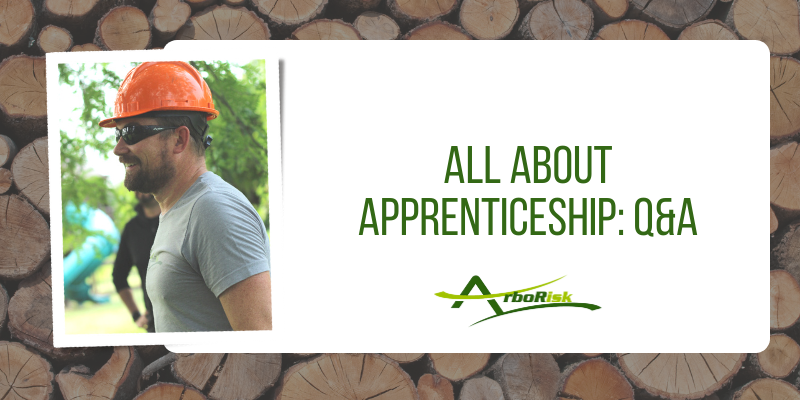By now, most tree care owners have heard of someone within the industry utilizing apprenticeships for their employee recruitment and development, but I know there are still a lot of questions out there surrounding this topic.
For this week’s tip, I was honored to interview two of the most influential and knowledgeable tree care owners on apprenticeships, August Hoppe of Hoppe Tree Service in Milwaukee, WI and Josh Morin of We Love Trees in Niwot, CO. They both gave some fantastic answers as well as very practical guidance for tree care companies wanting to explore this further.
Q – Are tree care apprenticeships here to stay or just a fad?
August – I believe, they are here to stay for sure, and only growing. Companies that use the program see the success and keep adding more employees into it. It’s a snowball effect. In Wisconsin, we hardly have to promote the program anymore, companies just keep adding enrollees.
Josh – In my view our society and our country is embracing models of learning and career preparation that allow you to earn money while you learn, instead of the traditional academic model which has many of our young people in a lot of debt. From what I hear from young people is that they don’t want to screw themselves with unnecessary debt, and they want meaningful work with a viable career path that will give them options in the future that isn’t a dead end. In my experience Arborist apprenticeship offers this. Will they last? We’ll see.
Q – What are the benefits you’ve personally seen with making apprenticeship a part of your tree care company’s recruiting strategy?
August – We have seen more and higher quality candidates that truly want a career, not just a job.
Josh – The challenge and bottleneck for growth for many businesses in our industry has been attracting people that are interested, willing and capable of doing the work. Apprenticeship which offers a structured learning process and incremental growth plan is attractive to a different type of person. It attracts people that understand that they will have to work hard and learn along the way, but they will get something out of it in return that will be valuable to them in the future.
Our industry has a diversity opportunity, so anything we can do to speak to more people of diverse backgrounds increases the size of the funnel of people we are recruiting into our industry.
Q – Can you attribute a dollar amount of growth your company has seen to the successful implementation of the apprenticeship within your company?
August – It’s hard to put a $ sign on culture or branding. But apprenticeship has definitely helped our employees understand that they are true professionals and they carry themselves that way. It gives them confidence and pride. Customers see that every day and want to work with companies that are excellent.
Josh – I also cannot attribute a dollar amount of growth, but I can say that attracting people who want to learn and grow is fundamental to the growth of a successful business.
Q – What are some of the challenges that tree care companies run into when starting down the apprenticeship path and how can they avoid some of them?
August – It’s scary to start as it seems like a lot of work with a lot of processes. But just like anything else in life, hard work pays off when it’s completed.
Josh – The owner and leaders of the company need to believe in the model and understand that investing in training and educating their employees is a company value and is of value to their company.
If the leadership of the company does not believe in the model of apprenticeship and does not see the benefit, then they will not be interested in investing in the related learning that is required with an apprenticeship program.
Q – How much of the business owner’s time is involved in setting up the apprenticeship and maintaining it?
August – It depends on each organization. I would recommend a business owner stays involved in setting up the program, but larger outfits may be able to delegate to an HR or training and safety manager for maintaining it once the business processes are figured out. At Hoppe Tree, we use a committee approach with a few staff members responsible for different parts of the apprenticeship program, including myself.
Josh – In my experience, setting up the apprenticeship program in terms of paperwork is fairly easy and takes a few hours, then, having an administrative person, sit down with the apprentice and explain the program and register them in the database. The challenge can be working the related learning into your business model. We try to schedule this classroom time during slower periods of business like in the winter.
Q – What would be your top piece of advice to tree care company owners regarding apprenticeship?
August – It’s a great way to train your employees in a consistent manner. It can improve culture, it helps with retention of employees, it leads to better recruitment, and also it helps our whole industry become more professional. Can you imagine what our industry will be like when we have 100,000 journey worker arborists?! Please get on board with this!
Josh – I recommend taking on the apprenticeship program with the goal of starting with one employee, and getting them through the program successfully and approaching the process as an experiment, and with curiosity so that you can learn as much as possible along the way, and figure out how, and if apprenticeship really lines up with the needs of your company and its people.
Thank you, August and Josh, for your time and passion in leading this very important and exciting development in the tree care industry! For more information on apprenticeships, check out the following resources:



Recent Comments